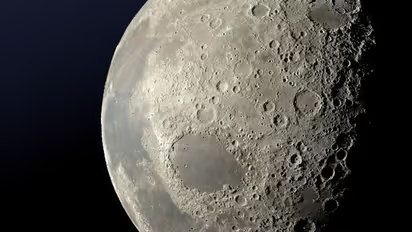Researchers confirm existence of cave network below Moon: Game changer for Lunar exploration and habitation

Synopsis
Scientists discovered a large cave near the Apollo 11 landing site on the Moon, accessible through a collapsed lava tube in the Sea of Tranquility. Radar data from NASA’s Lunar Reconnaissance Orbiter revealed the cave's existence, suggesting potential future lunar bases. The find could aid in understanding lunar geology and support extended human exploration missions.
Scientists have discovered a cave on the moon near where Neil Armstrong and Buzz Aldrin landed 55 years ago, and they believe there could be hundreds more that might one-day shelter astronauts.
On Monday, an Italian-led team revealed a groundbreaking discovery: evidence of a vast cave accessible from the moon's deepest known pit. This location is in the Sea of Tranquility, about 250 miles (400 kilometres) from the Apollo 11 landing site.
The pit, like over 200 others found on the moon, was formed when a lava tube collapsed.
A lava tube is a natural tunnel formed by flowing lava during a volcanic eruption. After the surface lava cools and hardens, the hot lava beneath continues to flow, eventually draining away and leaving a hollow, tube-like structure.
Researchers studied radar data from NASA’s Lunar Reconnaissance Orbiter and compared it with lava tubes on Earth. Their groundbreaking findings, published in *Nature Astronomy*, detail evidence of a large cave accessible from the moon's deepest known pit, led by an Italian team.
Leonardo Carrer and Lorenzo Bruzzone from the University of Trento expressed excitement to the Associated Press, stating, "After more than 50 years of mystery, confirming the existence of a lunar cave was thrilling."
In NASA's Apollo program, a total of 12 astronauts touched down on the Moon, beginning with Armstrong and Aldrin's historic landing on July 20, 1969.
The findings suggest there could be hundreds of pits and thousands of lava tubes on the Moon.
According to the study published in Nature, the discovered lunar cave presents an ideal site for a lunar base, offering shelter from harsh surface conditions and potential support for extended human exploration missions on the Moon.
However, the researchers noted that building habitats from scratch would be more time-consuming and challenging, even if the cave walls need reinforcement to prevent collapse.
British astronaut Helen Sharman told BBC News that humans might be able to use lunar pits as shelters in 20 to 30 years. However, due to the depth of these caves, they might need "jet packs or a lift" to get out.
Rocks and other materials inside these caves, untouched by harsh surface conditions for ages, can help scientists learn more about the Moon's evolution, especially its volcanic activity.
Scientists worldwide are continually expanding our knowledge of the Moon.
(The author of this article is a Defence, Aerospace & Political Analyst based in Bengaluru. He is also Director of ADD Engineering Components, India, Pvt. Ltd, a subsidiary of ADD Engineering GmbH, Germany. You can reach him at: girishlinganna@gmail.com)
Check the Breaking News Today and Latest News from across India and around the world. Stay updated with the latest World News and global developments from politics to economy and current affairs. Get in-depth coverage of China News, Europe News, Pakistan News, and South Asia News, along with top headlines from the UK and US. Follow expert analysis, international trends, and breaking updates from around the globe. Download the Asianet News Official App from the Android Play Store and iPhone App Store for accurate and timely news updates anytime, anywhere.